

Apchemistrynmsi.wikispaces. Welcome to The AP Chemistry National Math & Science Initiative Resources PageHere you will find lecture notes and review materials for each of the major units of study for the AP® Chemistry course.
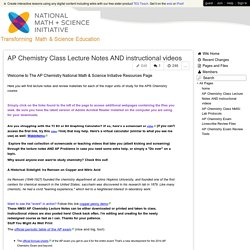
Simply click on the links found to the left of the page to access additional webpages containing the files you seek. Be sure you have the latest version of Adobe Acrobat Reader installed on the computer you are using for your downloads. Are you struggling with the TI 83 or 84 Graphing Calculator? If so, here's a screencast or video (if you can't access the first link, try this videolink) that may help. Here's a virtual calculator (similar to what you see me use) as well: Wabbitemu Why would anyone ever want to study chemistry? Unit 1 - Matter, Chemical Trends, and Chemical Bonding.
My Home Page » Grade 11 University-Preparation Chemistry (SCH 3U1) » Unit 1 - Matter, Chemical Trends, and Chemical Bonding Chapter 1 Answer Key Password: atom Chapter 2 Answer Key Password: bond Chapter 3 Answer Key Password: force 1.2 - Atomic Structure Note (PDF) (PDF 126 KB)
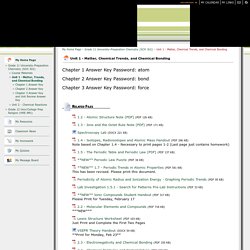
Teach21 Project Based Learning. The opening presentation for the entry event will contain some slides and a movie clip to show to students.
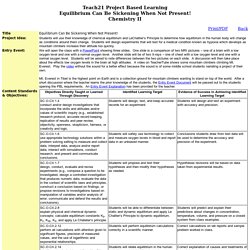
The slides will be of pictures of chest X-rays and brain MRI scans provided by a local radiologist. The material has been scanned and placed into the PowerPoint as slide two for the X-rays and slide three for the MRIs. Students will be grouped in teams of four. Each group will create their own contract at the outset of the PBL and create a checklist for dividing responsibilities. Each member will be accountable to all in the group for researching and collaborating on hypoxia and determine the course of their project as a group. Chap. 4 - Erickson's Chemistry. Introduction to Chemistry - CHEMSTEM. Unit 6 - Kinetics - MAEDA AP Chemistry. Unit 6 - Gas Laws - JOE'S CHEMISTRY WEBPAGE. Chem 11 - Mr. Lawson's Science Page.
Mr.T's Chemisty 11. Course: AP Chemistry - Hanson, Topic: Organic Chemistry. Unit 7-Intermolecular Forces - The Pursuit of Excellence. Honors Chemistry 633 (MODS ) AP Chemistry: Reading Guide for Section 1 and 2. Chemistry Courses at Newton South High School. Contents Purpose The purpose of this lab is to investigate the relationship between intermolecular forces and the properties of liquids.
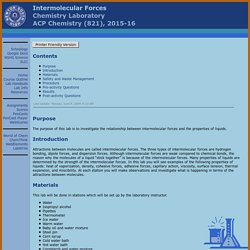
Introduction Attractions between molecules are called intermolecular forces. Mrs. Zuberbuehler - Mrs. Zuberbuehler. How to Tell if a Molecule is Polar or Non-Polar; VSEPR. These are problems using 3D molecules run in the application Jmol to help you visualize the molecule to determine if it is polar or non-polar.
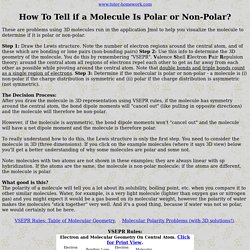
Step 1: Draw the Lewis structure. Note the number of electron regions around the central atom, and of these which are bonding or lone pairs (non-bonding pairs) Step 2: Use this info to determine the 3D geometry of the molecule. You do this by remembering "VSEPR". Valence Shell Electron Pair Repulsion theory; around the central atom all regions of electrons repel each other to get as far away from each other as possible while pivoting around the central atom.
Note that double bonds and triple bonds count as a single region of electrons. The Decision Process: After you draw the molecule in 3D representation using VSEPR rules, if the molecule has symmetry around the central atom, the bond dipole moments will "cancel out" (like pulling in opposite directions) and the molecule will therefore be non-polar.
ACP Chemistry. Unit 4 Bonding & Naming - Welcome to Flipped Chemistry. Chemistry Education Tools & Resources. Honors Chem - Unit 7B - Thermochemistry - Mrs. Pierce's Blog. AP Chemistry. All AP Chemistry students are required to participate in the annual Science Fair; this will be part of your final exam grade (students who take the AP exam are exempt from a written final exam).

Initial project proposals are due early in the first marking period (due Friday, 10/9), using the following form. Experimental projects with a clear chemistry tie-in are preferred. If you are having trouble coming up with a good topic, contact Dr V. Science Fair Project Timelines Science Fair Initial and Revised Proposal Form Poster Board--Experimental Projects Poster Board--Research Projects Science Fair Report Instructions You need to have a written report present at the actual science fair. Updated Science Fair Rubrics. Mr. Baker’s BCA Home Page. Specific Heat of Lead. Catalysis of the reaction between zinc and sulfuric acid. Zinc reacts with sulfuric acid to produce hydrogen.
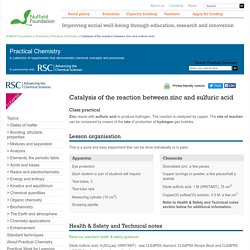
The reaction is catalysed by copper. The rate of reaction can be compared by means of the rate of production of hydrogen gas bubbles. This is a quick and easy experiment that can be done individually or in pairs. Granulated zinc, a few pieces Copper turnings or powder, a few pieces/half a spatula Dilute sulfuric acid, 1 M (IRRITANT), 15 cm3 Copper(II) sulfate(VI) solution, 0.5 M, a few cm3 Refer to Health & Safety and Technical notes section below for additional information. Thermochemistry - Mr. Scramling's Classes and More. Unit 5 is Chapter 6 our book.
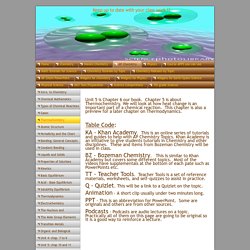
Chapter 5 is about Thermochemistry. 2015-2016 Honors Chem Weekly Assignments - Ami LeFevre. AP September - Mrs. Swan Science. Wednesday September 11 Chapter 3: Stoichiometry: Calculations with Chemical Formulas and Equations · Balancing chemical equations · Types of chemical reactions: synthesis, decomposition, displacement, combustion... · Percent composition Thursday September 12 Chapter 3: Stoichiometry, continued · The mole, molar mass and the GMA map · Empirical and molecular formulas.
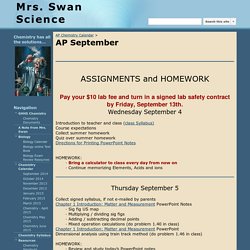
C4 – Aqeuous Reactions -Worksheets, Assignments and Other Information. SPECIAL NOTE: MP2 will only cover Sections 4.1, 4.2 and part of 4.4 (Activity Series).
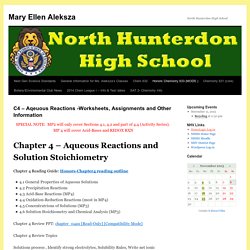
AP Chemistry Ch 4. 1E2a. The number of atoms, molecules, or formula units in a given mass of substance can be calculated. 1E2b. The subscripts in a chemical formula represent the number of atoms of each type in a molecule. 1E2c. The coefficients in a balanced chemical equation represent the relative numbers of particles that are consumed and created when the process occurs. 1E2d.
Aqueous Reactions and Solution Stoichiometry - The Pursuit of Excellence. Chapter 4 - Outline. Chapter 4 – Aqueous Reactions and Solution Stoichiometry 1. Solutions Introduction and Definitions Intermolecular Forces in Solutions Molarity and Solution Stoichiometry 2. Main Menu. Mrs. J's Chemistry Page - Lesson Materials. LoughmanCP1Chemistry.
Welcome to CP1 Chemistry! I hope that you enjoy Chemistry this year! I am looking forward to a fun and exciting year of a new way of teaching! Chemistry can be a challenging course for most students but I am hoping to make this a fun and exciting class for your son or daughter! This class is a mix of lecture, labs and class activities so there are many opportunities for your child to shine here! This is a formerly flipped class, so all of my videos are still on this website for your child to have access to for clarification of the concepts or if they were absent. The monthly calendar can be found here on the website and all assignments are located on this calendar. All review sheets for each test are also posted here and each student is expected to print a review sheet, complete it and hand it in on the day of the test for extra credit.
Students have the ability to check their grades and any missing work at all times at www.schoology.com. Pre-AP Chemistry - Home. Unit 01 - WHS PreAP Chemistry.